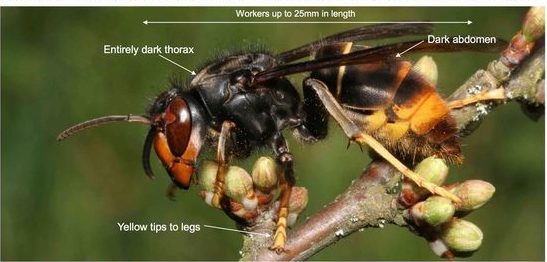
What is it?
The Asian Hornet, also sometimes called the Yellow-legged Hornet, Vespa velutina, is native to China and south east Asia. It was accidentally imported into France where it was first discovered in 2004. It is different from the European Hornet, which is mainly yellow and brown and does not have black legs with yellow ”feet”.
Where is it now?
It is now widespread throughout France and has spread into the surrounding countries. It has become established in the Channel Islands. Nests have been found in England in each year since 2016 but, so far, vigilance and prompt action has enabled these nests to be destroyed before they could release young queens in the autumn.
Why is Asian hornet a problem?
Asian hornets prey on insects in order to provide food for themselves and their grubs. They will capture and eat a wide variety of insects, including hoverflies, dragonflies and butterflies but are particularly attracted to bee hives because of the large numbers of honey bees available to them there. Once Asian hornets have located a beehive, they keep returning to catch worker bees as they enter or leave the hive. Honey bees soon learn there is danger outside and become reluctant to leave the hive. The amount of honey available to beekeepers is reduced, as is the pollination of flowers. Weakened hives can be invaded by Asian hornets and the entire bee colony wiped out.
What does Asian hornet look like?

Image courtesy APHA, Crown copyright
Asian hornets are 25-30mm (1-1¼’’) long. When viewed from above, the head and body are almost entirely black apart from a prominent orange-yellow band towards the rear end of the body. The tips of the legs are pale yellow.
The European hornet, Vespa crabro, is commonly found in Surrey. It is a little larger than Asian hornet and is predominantly yellow and brown in colour with brown tips to its legs. European hornets and other native UK species of social wasps sometimes feed on bees but are not a big problem.
If you think you have seen an Asian Hornet please click the button below to see the Asian Hornet Telephone Hotline numbers.
Where and when might I see Asian hornets?
Young Asian hornet queens overwinter in sheltered places. They become active in March-April when they may visit flowers in search of nectar. A queen will begin construction of her nest, which is made of a papery substance derived from wood fibres mixed with the hornet’s saliva. The initial nest may be in an outbuilding, roof space or in open air situations on a tree or shrub. Initially the queen is on her own and she does all the nest building and feeding of the first generation of worker hornet grubs. By early summer, the queen will have the assistance of worker hornets that take over nest construction and food gathering, allowing the queen to concentrate on egg laying.
Asian hornet workers may be seen near beehives at any time between late May and early November. They may also be seen anywhere there is an aggregation of insects for them to prey on. Ivy flowers in late August – October attract many insects and are a potential Asian hornet attractant. Other garden flowers and ripe fruit, such as apples, pears, plums and grapes, may also attract Asian hornets.
By late summer, an Asian hornet nest can contain several thousand hornets. During September – October the nest will be producing males and young queens. A single undetected nest could release about 200 mated queens that will go into winter resting places, ready to start new nests in the following spring.
If you think you have seen an Asian Hornet please click the button below for local beekeepers who can assist you further:
To track sightings of Asian Hornets the Government also provides a service.